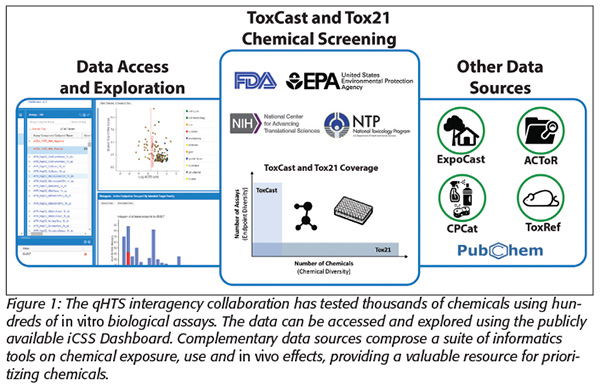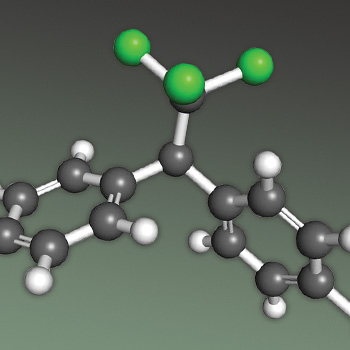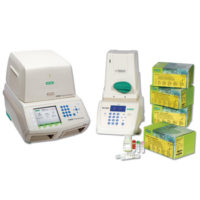In recent years, the food industry has made progress improving safety testing methods focused on microbial contaminants. However, food industry toxicologists must also assess the safety of food-relevant chemicals, including pesticides, direct additives and food contact substances. The rapidly growing use of new food additives, as well as innovation in food contact substance development, has increased the need to explore the use of high-throughput chemical toxicity testing approaches for food safety. Currently, the field of toxicology is undergoing a paradigm shift in how chemical hazards can be evaluated. There are tens of thousands of chemicals in use, many of which have little to no hazard information, and there are limited resources (namely time and money) for testing these chemicals. Advances in molecular and cellular biology, testing technologies and computational toxicology have paved the way for animal-free (in vitro) high-throughput screening (HTS) that can characterize chemical interactions with highly specific biological processes. These types of toxicological screening approaches are not novel; in fact, quantitative HTS (qHTS) methods that incorporate dose-response evaluation have been widely used in the pharmaceutical industry. For toxicological evaluation and prioritization, it is the throughput as well as the cost- and time-efficient nature of qHTS that make it ideal for the dose-dependent evaluation of thousands of chemicals for potential biological activity.
Collaborative Programs
Tox21
Ongoing qHTS testing programs include a diverse array of substances, including pesticides, industrial chemicals and food-relevant chemicals. For example, the Tox21 collaboration is a multi-agency, automated qHTS program aimed at efficiently testing and prioritizing chemicals for safety by increasing efficiency and reducing testing costs compared with traditional testing methods. Collaborators in the Tox21 program include the National Institute of Environmental Health Sciences/National Toxicology Program, National Institutes of Health National Center for Advancing Translational Sciences (NCATS), the U.S. Environmental Protection Agency (EPA) and the U.S. Food and Drug Administration.[1,2] Tox21 is currently testing a chemical library of nearly 10,000 chemicals utilizing robotics to automate 65 in vitro cell-based assays in 1,536-well plates generating data for nearly 1 million samples per week. All chemicals evaluated in the Tox21 program are tested in a 15-point dose response. The assays include measurement of cytotoxicity as well as other biological endpoints, including reporter gene assays informing chemical effects on nuclear receptor activation and assays evaluating stress pathways.[3] Data from the Tox21 program provide a foundation that will foster improved understanding of the toxicological effects of chemicals that are used in industrial and consumer products, “green” chemicals and food products. Specifically, nearly 1,700 food-relevant chemicals have been run in the Tox21 program, including direct and indirect food additives, food contact substances and pesticides.
ToxCast
In addition to the Tox21 qHTS effort, EPA’s ToxCast program has evaluated a subset of approximately 1,800 chemicals from Tox21 to expand biological endpoint coverage, providing a broader insight into potential biological impacts of chemical exposures. All chemicals are evaluated in at least six doses, and all data are analyzed using a custom-built data processing tool called the ToxCast Pipeline.[4] This computer program was created explicitly to allow for processing millions of data points generated from the Tox21 and ToxCast qHTS research programs. Of the chemicals screened in ToxCast, approximately 900 are food-relevant chemicals, while the remainder are classified as consumer products and industrial process-related. Widely diverse endpoints are evaluated in ToxCast. In contrast to Tox21, where all chemical screening is conducted at NCATS using robot automation, the ToxCast program includes assays in a multitude of different in vitro platforms and assay technologies achieved by collaboration with external partners. ToxCast assays include both cell-based and cell-free assays. Although the majority focus on human endpoints, there are assays that currently represent 10 species. Assays range from single endpoint to multiplexed readouts using various measurement technologies. The diversity in biochemical assay coverage allows for a more comprehensive evaluation of a chemical’s possible bioactivity.
Program Highlights
 A hallmark of the ToxCast and Tox21 research programs is public transparency. All data are publicly available and accessible through their respective web pages.[5,6] For ToxCast, all programming code used for data analyses is publicly available. EPA has also developed an interactive dashboard[3] to facilitate the exploration and use of both Tox21 and ToxCast data, which allows users to search by chemical and/or assay, visualize the resulting subsets of data and export any data of interest (Figure 1).
A hallmark of the ToxCast and Tox21 research programs is public transparency. All data are publicly available and accessible through their respective web pages.[5,6] For ToxCast, all programming code used for data analyses is publicly available. EPA has also developed an interactive dashboard[3] to facilitate the exploration and use of both Tox21 and ToxCast data, which allows users to search by chemical and/or assay, visualize the resulting subsets of data and export any data of interest (Figure 1).
The Tox21 and ToxCast qHTS programs have gained recognition for their innovation and leadership in building the infrastructure required for the use of high-throughput in vitro-based chemical screening in regulatory decisions. These projects demonstrate that qHTS efficiently tests chemicals and provides the empirical data that allow prioritization of chemicals for further toxicological testing. It is important to note that bioactivity in an in vitro assay does not necessarily indicate toxicity in vivo, and consistent with all scientific data, interpretation of these large data sets requires expertise and scientific judgment. Nonetheless, these publicly available data sets are valuable to toxicologists at large, and specifically the food industry, given the large number of food-relevant chemicals that have been tested. Further, additional information that may be garnered from these data includes identification of assays that are sensitive for capturing food chemical-elicited bioactivity and identification of chemical motifs associated with activity, both of which can be incorporated into product development and front-end safety testing.
Program Challenges
Several challenges in working with in vitro qHTS data are being addressed. For example, extrapolation of such data to in vivo doses is essential to lend context to results. The toxicity reference database[7] summarizes in vivo animal toxicity testing results to help link qHTS to adverse health effects. However, the data required for reverse toxicokinetics extrapolations to convert in vitro testing concentrations into doses in target tissues are often unavailable. Moreover, not all chemicals have sufficient exposure data or, in some cases, production volume data, further complicating the contextualization of screening results. In parallel to the ToxCast program, EPA’s ExpoCast program comprises high-throughput computational exposure models that aim to address this exposure data gap.[8] A new resource, the Chemical and Product Categories (CPCat) database,[9] provides information that maps 43,000 unique chemicals to a set of 850 consumer and industrial-use categories. ExpoCast and CPCat combined provide data useful for predicting exposure potential for tens of thousands of chemicals. The ExpoCast estimates are the exposure equivalents of bioactivity data available from ToxCast and Tox21. This suite of tools allows for rapid prioritization of chemicals based on potential for risk by combining the hazard (bioactivity) and exposure predictions. While the use of qHTS data in the food industry is in its infancy, these data are being incorporated into prioritization efforts. For example, EPA’s Endocrine Disruption Screening Program (EDSP) is using HTS data to prioritize the thousands of chemicals that EPA is required to evaluate for potential endocrine disruption. A recent Federal Register Notice outlines the agency’s intent to use HTS data in the EDSP.[10]
With the number of chemicals used in the food industry and found in the environment increasing, cost- and time-efficient in vitro high-throughput methods and new predictive exposure models are providing toxicologists, exposure scientists and regulators better data and tools to estimate the risk potential of chemicals. Ongoing efforts to improve and update these new tools to better predict hazards and exposures will continue to offer valuable data that are driving in vitro qHTS to the forefront in toxicology. Tox21 and ToxCast plan to maintain a tradition of publicly releasing all data collected as part of consortium efforts and will continue to work closely with stakeholders to determine the most appropriate use of these new chemical data.
The views expressed in this article are those of the authors and do not necessarily represent the views or policies of EPA.
Christina L. Baghdikian, M.P.H., is an American Schools and Programs of Public Health fellow and a Presidential Management Fellows finalist at EPA’s National Center for Computational Toxicology, working on stakeholder outreach and communication.
Agnes L. Karmaus, Ph.D., is an ORISE postdoctoral research scientist at EPA’s National Center for Computational Toxicology, working on analyzing and modeling ToxCast data.
References
1. www.epa.gov/ncct/Tox21.
2. ncats.nih.gov/tox21.
3. actor.epa.gov/dashboard2.
4. www.epa.gov/ncct/toxcast/data.html.
5. epa.gov/ncct/toxcast.
6. pubchem.ncbi.nlm.nih.gov.
7. www.epa.gov/ncct/toxrefdb.
8. www.epa.gov/ncct/expocast.
9. actor.epa.gov/cpcat.
10. www.federalregister.gov/articles/2015/06/19/2015-15182/use-of-high-throughput-assays-and-computational-tools-endocrine-disruptor-screening-program-notice.
High-Throughput Toxicity Testing: New Strategies for Assessing Chemical Safety



